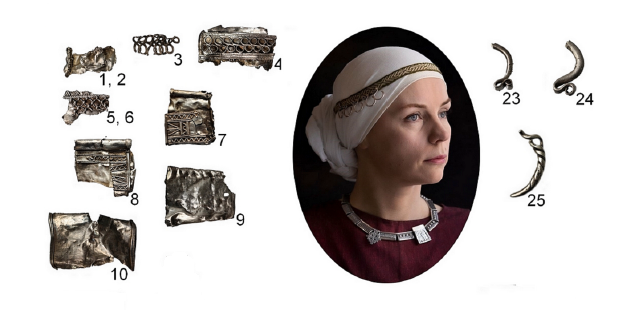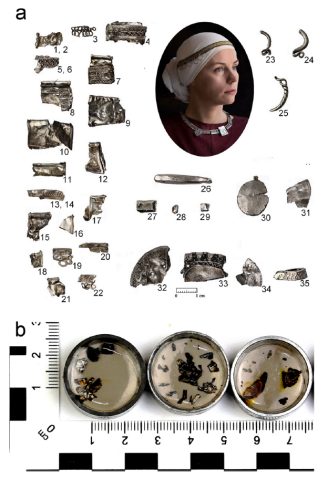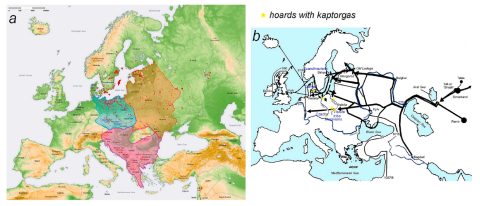
Viking period amulet research reveals ancient trade routes across Poland
01-03-2024
With the possibilities of modern material research, the discoveries of archaeologists can provide valuable information. The latest archaeometric analyses of unique artefacts made of silver have not only brought closer the craft techniques of the Viking period, but also indicated possible routes by which goods were transported in the Polish territories.
Buried silver hoards are, in parts of Europe, a distinctive remnant of Viking influence from the early Middle Ages (8th to 11th century). They consisted of coins, usually dirhams (a silver coin found in Islamic countries during this period), as well as ornaments, bars and other objects made of silver, sometimes gold. These were partly buried to protect them from looting, but were largely made as offerings to the gods - a tradition that dates back to the Stone Age. A very large number of such treasures are discovered in Central and Eastern Europe, especially in Poland, where about 700 are currently inventoried in museums (this is the second largest number in the world, more - about 800 - have been found in the Gotland area). The treasure may include up to tens of thousands of objects, generally in chopped form. These deposits, due to the small availability of written sources from the early period of the formation of the Polish state, are a source of information on the history of metal trade and the development of metalworking in Central Europe, and thus tell us about trade contacts and the interpenetration of technological ideas among the population.
 One of the unique archaeological finds from this period is a hoard discovered in the village of Piaski-Dramino in the West Pomeranian Voivodeship. Found in clay vessels, the valuables (in chopped form) with a total weight of over 11 kg included, among others, fragments of silver coins, bars, earrings, fragments of necklaces and bracelets, as well as the largest collection of so-called kaptorgas (over 100 fragments) discovered so far. A kaptorga (Turkish for 'box worn at the waist') was a small rectangular or trapezoidal-shaped box in which materials such as herbs (fragrances), seeds, clay lumps, glass fragments or even bones (relics) were placed. Kaptorgas were worn as necklaces and treated as amulets with protective properties. The oldest pieces, analogous to those from the Piaski-Dramino treasure, were found in the Czech Republic, inside the tombs of a local princely family, and it is the Czech Republic that is indicated as the place of their creation. Later finds in Poland indicate the direction of the spread of such objects - along the Oder and Warta rivers and further to Scandinavia.
One of the unique archaeological finds from this period is a hoard discovered in the village of Piaski-Dramino in the West Pomeranian Voivodeship. Found in clay vessels, the valuables (in chopped form) with a total weight of over 11 kg included, among others, fragments of silver coins, bars, earrings, fragments of necklaces and bracelets, as well as the largest collection of so-called kaptorgas (over 100 fragments) discovered so far. A kaptorga (Turkish for 'box worn at the waist') was a small rectangular or trapezoidal-shaped box in which materials such as herbs (fragrances), seeds, clay lumps, glass fragments or even bones (relics) were placed. Kaptorgas were worn as necklaces and treated as amulets with protective properties. The oldest pieces, analogous to those from the Piaski-Dramino treasure, were found in the Czech Republic, inside the tombs of a local princely family, and it is the Czech Republic that is indicated as the place of their creation. Later finds in Poland indicate the direction of the spread of such objects - along the Oder and Warta rivers and further to Scandinavia.
Material testing, both destructive and non-destructive, can provide a wealth of information about an object. Analysis of the structure and content of individual elements or their isotopes in archaeological finds can be used to determine precisely where they originated, as well as their manufacturing techniques. During recent research, the fragments comprising the Piaski-Dramino hoard were subjected to such studies, including scanning electron microscopy with X-ray microanalysis (SEM-EDS), energy dispersive X-ray fluorescence spectroscopy (ED-XRF), and inductively coupled plasma ionisation mass spectrometry (ICP-MS), including its high-resolution variant for determining lead isotopic ratios. The geochemical studies on the isotopic provenance of the monuments were conducted in collaboration with Prof Ryan Mathur of Juniata Collegue, Pennsylvania. "The analyses show that all the artifacts studied have been technologically altered in terms of composition, compared to the raw materials, as evidenced, for example, by the admixture of copper," - says Ewelina Miśta-Jakubowska, PhD, from the NCBJ's Department of Particle Acceleration Physics and Technology, first author of the paper. "The kaptorga fragments are made of high-quality silver, up to 95% of the total mass, but some specimens differ in their lead, tin and zinc content. Similarly, differences in admixtures are evident in fragments of other objects, such as bars, where the need for moulding involved the addition of low-melting components such as tin or zinc."
Based on the results obtained, especially the lead isotope content, the artifacts included in the Piaski-Dramino hoard were divided into several categories in terms of the origin of the materials used to produce them. Most of them were made from silver from the remelting of dirhams, which was a common method of silver recovery in medieval times. Some fragments contained a mixture of silver from remelted coins and ore mined in the Silesian Uplands and Kraków or Germany (Rammelsberg), and some were made exclusively from ore mined in the Silesian region. In addition, the analysis of silver isotope content, which is only just emerging in archaeometry, has led to some new conclusions. "Some of the examined fragments, despite similar lead isotopic composition, differ significantly in silver isotope composition, which may mean that silver from different sources or silver subjected to different processing methods was used to make a single ornament," describes Miśta-Jakubowska, PhD. "Moreover, for the first time in this work, we examined the isotopic composition of silver bars, and its correspondence with other fragments confirmed that it was from such bars that these types of ornaments were produced."

The results of the researchers' studies indicate that the ornaments included in the Piaski-Dramino hoard were made by Czech craftsmen. The silver used to produce the ornaments, obtained from the melting of dirhams, came from local trade in the territory of the Vistula tribes who controlled the flow of silver in the form of dirhams, as well as from raw material mined in the areas of the Silesian Uplands and Kraków. In the period from which the treasure comes, both Upper Silesia and Kraków were under Czech rule. It is therefore likely that the early medieval silver objects found in what is now the Czech Republic are also of similar composition and origin.
Original paper:
Ewelina Miśta-Jakubowska, Władysław Duczko, Anna B. Kowalska, Renata Czech-Błońska, Ryan Mathur, Aneta Gójska, Dariusz Rozmus, Rafał Siuda, Dariusz Oleszak, Agnieszka Brojanowska, Jan Klimaszewski, Amulets from Viking-age Baltic coast: A unique hoard from Piaski-Dramino (Poland) in the light of provenance and technological research of silvercraft art, Journal of Archaeological Science: Reports, Volume 53, 2024, 104356, ISSN 2352-409X, https://doi.org/10.1016/j.jasrep.2023.104356.





